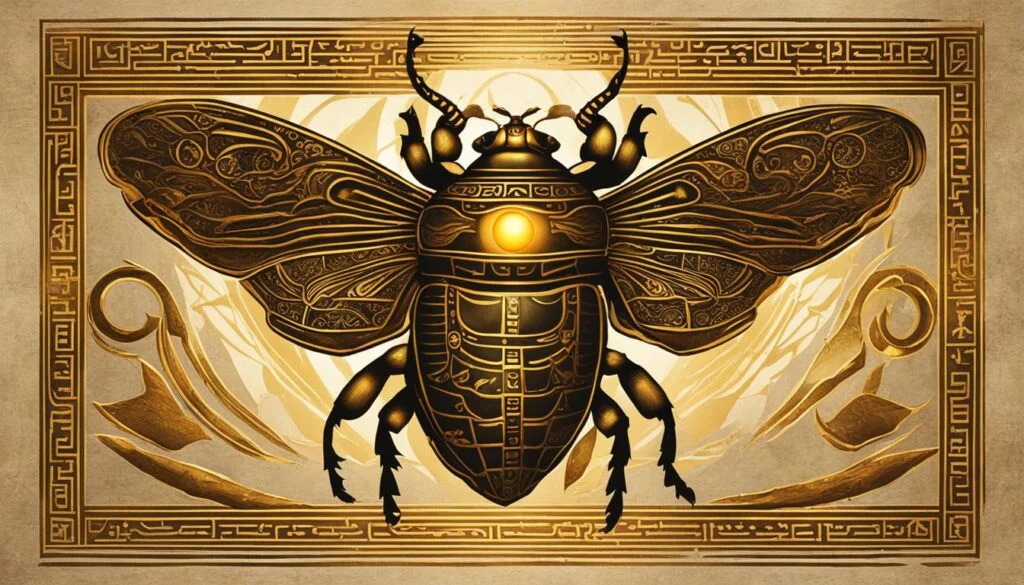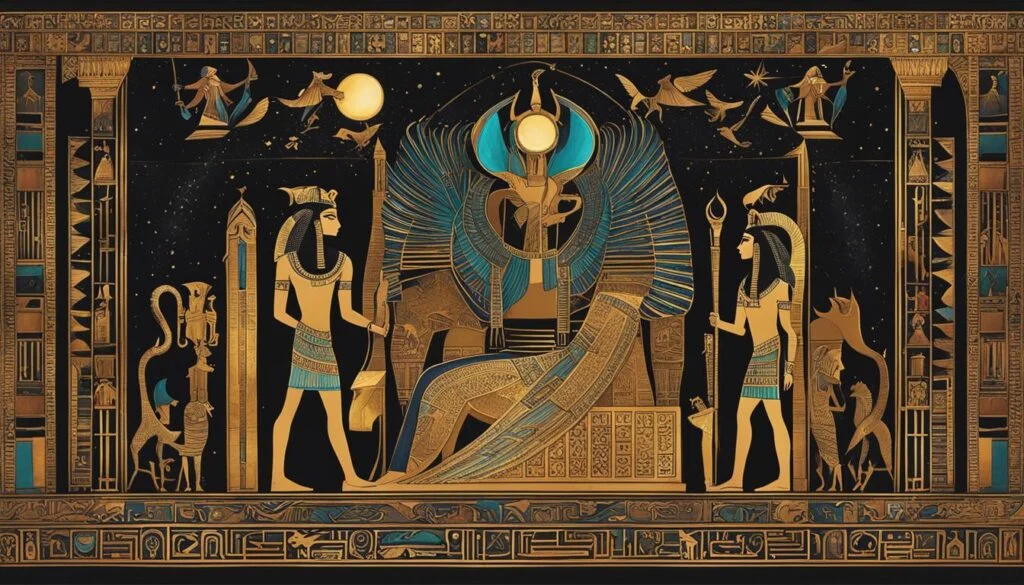In ancient Egyptian religion and mythology, the scarab beetle, also known as Khepri, held a sacred role.
It symbolized the creative and transformative power of the sun, represented by the morning sun god Re.
The beetle was associated with rebirth and resurrection, as it lay its eggs in a ball of dung and the young beetles emerged after a period of transformation. The scarab beetle was believed to be an incarnation of the god Khepri and was used as an amulet for protection and to ensure rebirth in the afterlife.
Key Takeaways:
- The scarab beetle symbolized the creative and transformative power of the sun in ancient Egyptian mythology.
- It was associated with rebirth and resurrection, reflecting the cycle of life.
- The scarab beetle was believed to be an incarnation of the god Khepri and was used as an amulet for protection and to ensure rebirth in the afterlife.
- Its significance in Egyptian culture is reflected in its depiction in art and its use in jewelry.
- The scarab beetle continues to hold cultural significance and symbolism in modern times as a representation of Egyptian heritage.
The Symbolism of the Scarab Beetle in Ancient Egypt
In ancient Egyptian culture, the scarab beetle held great significance and symbolized various aspects of their beliefs.
The beetle represented the god Khepri, who embodied the power of the sun to create new life.
This association with the sun led to the scarab beetle being closely associated with concepts of rebirth and resurrection.
The ancient Egyptians believed that life emerged from the darkness of the underworld, much like a scarab beetle emerging from a ball of dung.
This transformative process of the beetle laying its eggs and the young beetles emerging became a powerful symbol of renewal and the eternal cycle of life.
Due to its connection to the sun and its association with life and rebirth, the scarab beetle was worshipped as a sacred symbol in ancient Egypt.
It was often used in religious rituals and ceremonies and held a central role in the belief system of the time.
People would wear amulets and charms in the shape of scarab beetles, believing that these objects provided protection and ensured rebirth in the afterlife.
The scarab beetle was also frequently buried with the deceased, serving as a guide and offering a safe passage through the underworld to the realm of the gods.
As a result, the scarab beetle became an integral part of ancient Egyptian religious practices and held significant cultural importance.
Its symbolism and worship played a crucial role in the lives and beliefs of the ancient Egyptians, highlighting their deep reverence for the cycle of life and the power of the sun.
The Role of the Scarab Beetle in Ancient Egyptian Art

In ancient Egyptian art, the scarab beetle held a significant and prominent position. It was a common subject for sculptures, paintings, and hieroglyphics, showcasing its importance in Egyptian culture.
The depiction of the scarab beetle in art symbolized various concepts such as rebirth, transformation, and the sun’s daily journey across the sky.
The scarab beetle was often represented rolling the sun disk, a symbol associated with the god Khepri.
This depiction represented the movement of the sun and the eternal cycle of life, emphasizing the beetle’s connection to the creative and transformative power of the sun.
Moreover, the scarab beetle was also utilized as a decorative motif in jewelry and other personal adornments.
Its inclusion in jewelry designs further emphasized its symbolic significance and showcased the Egyptians’ appreciation for the beetle’s association with rebirth and protection.
To get a visual representation of the scarab beetle in ancient Egyptian art, take a look at the image below:
The Use of Scarab Amulets in Ancient Egypt
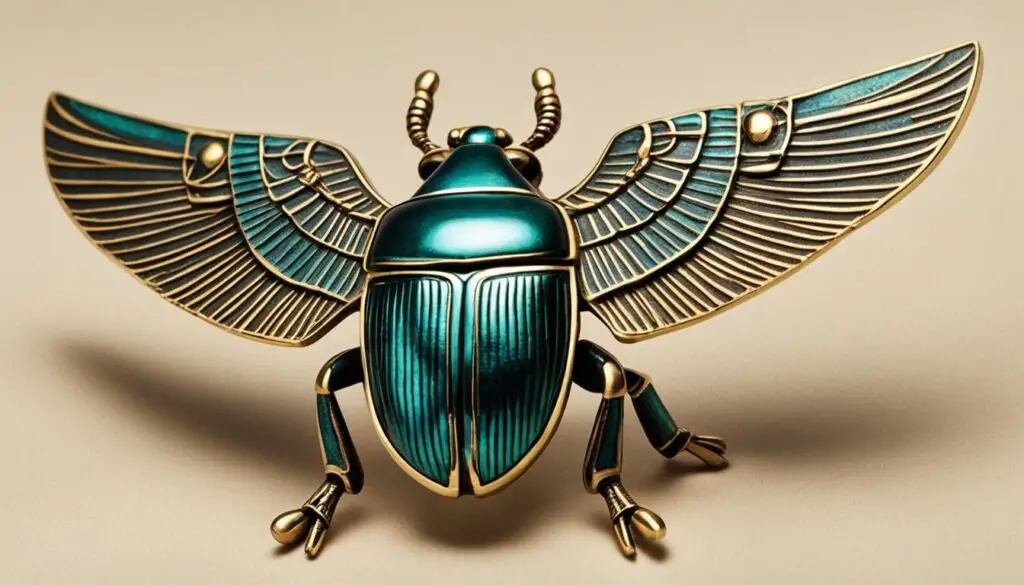
In ancient Egypt, the scarab beetle held great significance and was commonly used as an amulet.
These amulets were crafted in the shape of scarab beetles and believed to harness the power and protection of the god Khepri.
They played a crucial role in ancient Egyptian funerary practices, as they were often buried with the deceased to ensure a successful journey through the afterlife.
Scarab amulets were inscribed with sacred texts from the Book of the Dead, a collection of mortuary spells and prayers.
These inscriptions were believed to guide and support the soul of the deceased in the afterlife.
The scarab beetle, as an emblem of rebirth and transformation, symbolized the cyclical nature of life and death.
Scarab amulets were not limited to funerary contexts. Individuals also wore scarab amulets as personal charms for protection and good luck in their daily lives.
The beetle’s association with Khepri, the morning sun god, further reinforced the belief in its divine powers.
The use of scarab amulets in ancient Egypt encapsulates the deep-rooted connection between religion, mythology, and daily life.
These powerful and visually striking artifacts serve as a testament to the profound significance of the scarab beetle in Egyptian culture.
The Historical Significance of the Scarab Beetle in Egypt

The worship of the scarab beetle predates the worship of the sun god Re in ancient Egypt.
According to some myths, the god Khepri himself arose from the primeval chaos and created the universe.
In other variations, it was Re who created the universe in the form of Khepri. The beetle symbolized the creative and transformative power that brought forth life from inert matter.
It played a central role in the creation myths and the lineage of the Egyptian gods.
Five Facts About Scarab Beetles:
- ✅ The scarab beetle predates the worship of the sun god Re.
- ✅ According to myths, Khepri or Re created the universe.
- ✅ The beetle symbolized creative and transformative power.
- ✅ The scarab beetle played a central role in creation myths.
- ✅ It influenced the lineage of the Egyptian gods.
Scarab Beetle Artifacts and Archaeological Findings
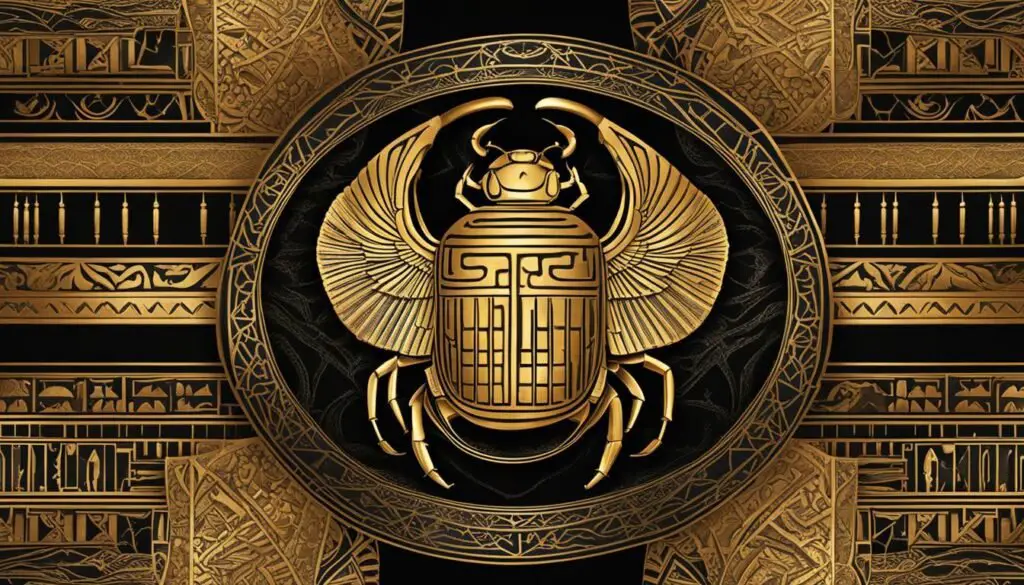
Archaeological findings in Egypt have revealed a treasure trove of scarab beetle artifacts, shedding light on the profound significance of the scarab beetle in ancient Egyptian culture.
These artifacts include scarab amulets, scarab-shaped seals, and scarab decorations on various sacred objects.
Scarab amulets and seals were particularly prevalent, serving as tangible representations of the protective and transformative power associated with the beetles.
Many of these amulets were inscribed with texts from the Book of the Dead, a collection of mortuary guides that guided the deceased through the afterlife.
It is believed that the scarab amulets provided spiritual protection and ensured a safe journey through the underworld.
The wide variety of scarab beetle artifacts discovered in Egypt not only highlights the prevalence of scarab beetle symbolism but also provides valuable insights into the beliefs and practices of the ancient Egyptians.
These artifacts showcase the Egyptians’ deep reverence for the scarab beetle and their belief in its ability to bestow protection, rebirth, and eternal life.
Mythological Associations of the Scarab Beetle in Ancient Egypt
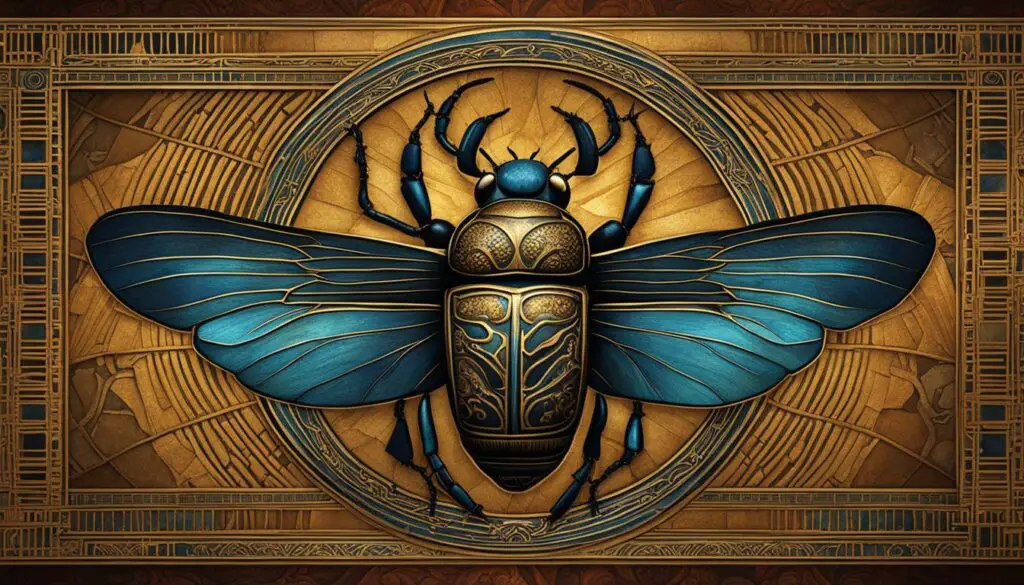
The ancient Egyptian culture held various mythological associations with the sacred scarab beetle.
Closely connected to the god Khepri and the sun’s daily journey, the scarab beetle symbolized themes of resurrection and rebirth.
In the ancient Egyptian belief system, the scarab beetle was considered a powerful protective symbol that guided and aided the deceased on their journey through the underworld.
The scarab beetle’s significance in Egyptian religion reflects the ancient Egyptians’ belief in the cyclical nature of life and death.
It exemplifies their understanding of the continuity of existence and the concept of eternal life.
The beetle’s association with rebirth and transformation made it a potent symbol in funerary rituals and the afterlife.
To honor and acknowledge the role of the scarab beetle in their mythology, the ancient Egyptians crafted intricate amulets and talismans in the shape of the beetle, which were buried alongside the deceased.
These amulets, often inscribed with protective spells and markings, were believed to provide guidance and assistance to the deceased soul.
Key Mythological Associations of the Scarab Beetle:
- Resurrection and Rebirth: The scarab beetle symbolized the cycle of life and was associated with the idea of resurrection and rebirth.
. - Protection and Guidance: The beetle offered powerful protection and guidance to the deceased in their journey through the afterlife.
. - Cyclical Nature of Life: The scarab beetle’s mythological significance reflected the ancient Egyptians’ belief in the cyclical nature of existence and the eternal cycle of life and death.
The enduring mythological associations of the scarab beetle in ancient Egypt continue to captivate and fascinate people today, reminding us of the rich belief systems and cultural heritage of this ancient civilization.
Modern Interpretations and Cultural Significance of the Scarab Beetle

The scarab beetle holds a remarkable place in modern times, symbolizing the rich cultural heritage of Egypt.
It serves as a powerful representation of Egyptian culture and is often featured in art and design, both within Egypt and around the world.
The scarab beetle’s symbolism of rebirth and transformation resonates with many individuals, making it a popular choice for use in spiritual and symbolic practices.
The scarab beetle’s enduring significance stems from its association with ancient Egyptian mythology, where it represented the rejuvenating power of the sun and the eternal cycle of life.
This symbolism continues to captivate people, evoking a sense of awe and wonder. The scarab beetle serves as a timeless reminder of Egypt’s fascinating history and mythology.
The Influence of the Scarab Beetle on Egyptian Jewelry
The scarab beetle had a significant influence on Egyptian jewelry design. Scarab-shaped amulets, pendants, and rings were popular adornments, often made from precious metals and gemstones.
These pieces of jewelry not only showcased the skill and craftsmanship of ancient Egyptian artisans but also reflected the symbolic importance of the scarab beetle.
The beetle’s association with rebirth, protection, and good luck made it a desirable motif in jewelry design.
Ancient Egyptian jewelry featuring scarab beetles were intricately crafted, with attention to detail and exquisite materials.
Gold and semi-precious gemstones were commonly used to create scarab-shaped amulets and pendants.
These jewelry pieces were often worn as talismans for protection and to attract good fortune.
The scarab beetle’s symbolism as a representation of rebirth and transformation made it a popular motif in Egyptian jewelry.
Scarabs were frequently depicted with their wings extended, evoking a sense of motion and power.
The iconic shape of the scarab beetle was incorporated into various types of jewelry, from necklaces and bracelets to rings and earrings.
The scarab motif was also engraved or painted onto other decorative elements, such as scarab seals and scarab-shaped beads.
One of the most intriguing aspects of ancient Egyptian jewelry featuring scarab beetles is the use of vibrant colors.
The gemstones used to adorn the scarab-shaped jewelry, such as lapis lazuli, carnelian, and turquoise, added a touch of brilliance and symbolism to the pieces.
These colors were believed to possess protective and spiritual qualities that enhanced the power and meaning of the scarab beetle.
The influence of scarab beetles on Egyptian jewelry can still be seen today. Modern jewelry designers often draw inspiration from the ancient Egyptians, incorporating scarab motifs into their designs.
Scarab-shaped pendants, earrings, and rings remain popular choices for those seeking jewelry with a connection to Egyptian symbolism and culture.
As a powerful symbol of rebirth and protection, the scarab beetle continues to captivate us with its timeless beauty and significance.
Whether in ancient artifacts or modern designs, the scarab beetle’s presence in Egyptian jewelry showcases the enduring appeal and cultural importance of this ancient civilization.
Artistic Representation of Scarab Beetle in Egyptian Jewelry
The use of the scarab beetle in Egyptian jewelry was not limited to its physical form alone.
Ancient artisans also depicted scarab beetles symbolically in their designs. One example is the use of the winged scarab motif, often represented with outstretched wings and a stylized body.
This representation emphasized the scarab’s association with the sun god and the power of transformation.
Another symbolic representation of the scarab beetle in Egyptian jewelry was the scarab with the sun disk.
This design depicted the scarab pushing the sun disk across the sky, symbolizing the sun god’s daily journey and the cyclical nature of life.
This imagery reinforced the scarab’s role as a symbol of rebirth and the eternal cycle of life.
The combination of symbolic representation and exquisite craftsmanship made scarab beetle jewelry an integral part of ancient Egyptian culture.
These timeless pieces continue to inspire us today with their beauty and the rich symbolism they hold.
The Cultural Significance of the Scarab Beetle in Modern Egypt
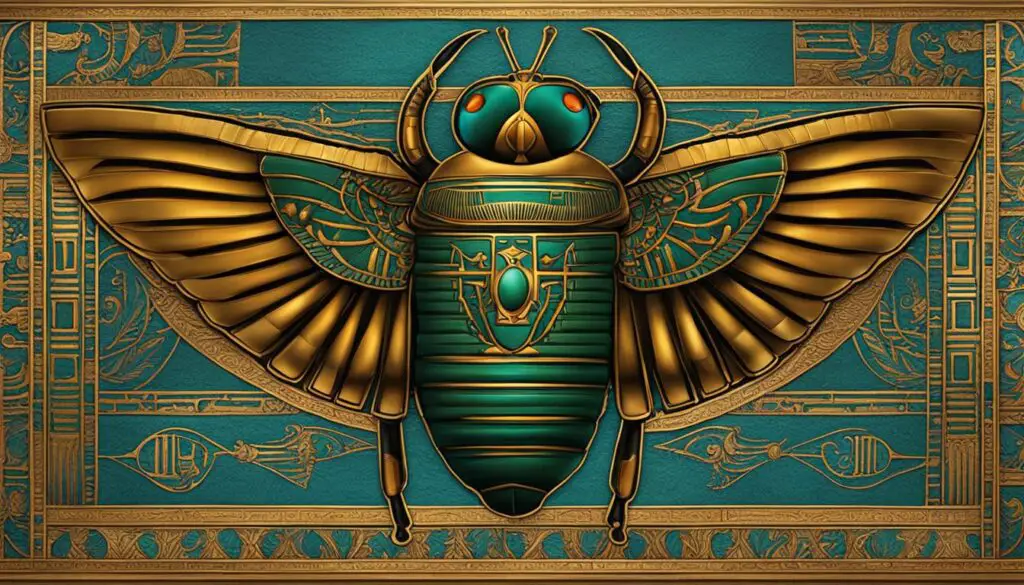
The scarab beetle continues to play a prominent role in modern Egyptian culture, serving as a symbol that is deeply ingrained in everyday life.
This ancient creature can be found in various aspects of Egyptian society, from architecture and artwork to religious practices and tourism.
The scarab beetle holds a powerful symbolism of rebirth and transformation, which resonates strongly with the Egyptian people.
It serves as a constant reminder of their rich and ancient heritage, connecting them to their roots and the cyclical nature of life.
Architecture in Egypt often incorporates the scarab beetle motif, with sculptures and carvings adorning buildings and monuments.
These iconic representations serve as a visual tribute to the enduring legacy of the scarab beetle in Egyptian culture.
Artwork is another realm where the scarab beetle shines. Paintings, sculptures, and jewelry often feature the intricate and detailed form of the beetle, showcasing its cultural significance and symbolism.
It is not uncommon to find scarab-themed artwork displayed in galleries and museums, captivating both locals and international visitors.
Religious practices in Egypt also pay homage to the scarab beetle. The beetle’s symbolic association with rebirth and immortality aligns perfectly with the beliefs and rituals of the Egyptian people.
The scarab beetle is revered as a sacred creature, often used in spiritual ceremonies and offerings.
Scarab Beetle Tourism
Egyptian tourism is greatly influenced by the cultural significance of the scarab beetle.
Visitors from around the world flock to Egypt, eager to experience the country’s ancient history and immerse themselves in its mystical past.
Scarab-themed souvenirs and artifacts are highly sought after by tourists, who recognize the beetle as a symbol of Egypt’s rich heritage.
These items serve as mementos of their visit, allowing them to take a piece of Egyptian culture and symbolism back home with them.
Overall, the scarab beetle holds a special place in modern Egyptian culture. Its symbolism, artistic representation, and influence on religious practices and tourism make it a cherished and enduring symbol of Egypt’s ancient glory.
The Fascination with Ancient Egyptian Mythology and Symbolism
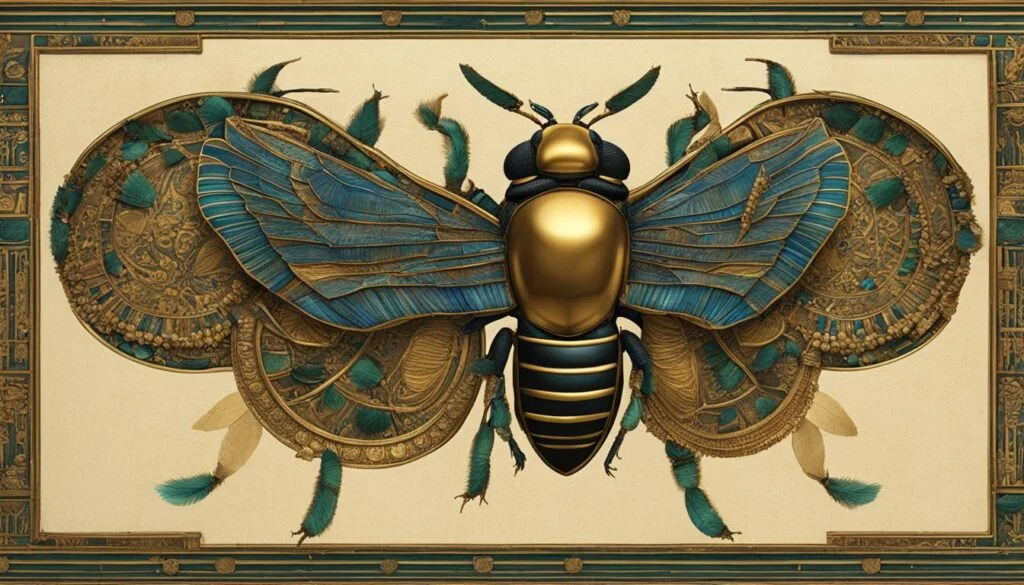
Ancient Egyptian mythology and symbolism have captivated people around the world for centuries.
The rich and complex belief system of the ancient Egyptians, with its gods, goddesses, and mythical creatures, continues to inspire awe and curiosity.
One particularly fascinating aspect of this mythology is the significance of the scarab beetle in Egyptian religion.
The scarab beetle, also known as Khepri, played a sacred role in ancient Egyptian culture.
It symbolized the creative and transformative power of the sun, represented by the morning sun god Re.
This beetle was associated with rebirth and resurrection, as it laid its eggs in a ball of dung and the young beetles emerged after a period of transformation.
The scarab beetle was believed to be an incarnation of the god Khepri and was used as an amulet for protection and to ensure rebirth in the afterlife.
The fascination with ancient Egyptian mythology and symbolism serves as a testament to the enduring power and intrigue of these ancient traditions.
It reflects the Egyptians’ deep connection to the natural world and their beliefs in the cyclical nature of life.
To this day, people around the world are captivated by the mystique and symbolism of ancient Egypt, finding inspiration in its rich mythology and the sacred significance of the scarab beetle.
The Role of the Scarab Beetle in Egyptian Religion
- Symbol of the sun: The scarab beetle represented the morning sun god Re and the power of the sun to create new life.
. - Symbol of rebirth: The beetle’s association with transformation and resurrection made it a powerful symbol of rebirth in the afterlife.
. - Protective amulet: Scarab beetles were commonly used as amulets for protection and to ensure a successful journey through the underworld.
Throughout history, the scarab beetle has remained an enduring symbol of ancient Egyptian culture and continues to fascinate people with its rich symbolism and spiritual significance.
Its role in Egyptian mythology is a testament to the deep-rooted beliefs and values of the ancient
Egyptians, and its enduring allure is a testament to the enduring power and intrigue of these ancient traditions.
Final Thoughts
The ancient Egyptian beetle god, known as the scarab beetle, played a crucial role in the mythology and culture of ancient Egypt.
This small creature symbolized rebirth, transformation, and the life-giving power of the sun, making it a cherished and revered symbol.
The scarab beetle was integrated into various aspects of Egyptian life, from religious practices and art to everyday customs.
Today, the scarab beetle’s cultural significance continues to captivate people around the world.
Its symbolic representation of renewal and the cyclical nature of life resonates deeply, serving as a testament to the enduring fascination with ancient Egyptian mythology.
The scarab beetle’s ability to evoke a sense of awe and wonder makes it an enduring symbol of Egypt’s rich history and complex belief system.
With its fascinating history and profound symbolism, the scarab beetle remains an intriguing and cherished cultural icon.
It serves as a reminder of the ancient Egyptians’ deep connection with the natural world and their belief in the power of transformation.
Whether as a religious symbol, an artistic motif, or a piece of jewelry, the scarab beetle continues to inspire and captivate, keeping the spirit of ancient Egypt alive in the modern world.
Frequently Asked Questions
Q: Are scarab beetles dangerous?
A: Scarab beetles are not dangerous to humans. They are generally harmless and do not bite or sting.
Q: What mythological associations did the scarab beetle have in ancient Egypt?
A: In ancient Egypt, the scarab beetle was associated with the sun god Ra and regeneration. They believed scarab beetles rolled the sun across the sky each day and represented rebirth and renewal.
Q: Are scarab beetles really flesh-eating?
A: No, scarab beetles are not flesh-eating. Most species of scarab beetles feed on plant material, decaying matter, and dung.
Q: What artifacts have been found related to the scarab beetle in ancient Egypt?
A: Numerous artifacts related to scarab beetles have been found in ancient Egypt, including amulets, seals, jewelry, and burial items. These artifacts often bore inscriptions and were used as symbols of protection and power.
Q: Can scarab beetles kill you?
A: No, scarab beetles cannot kill you. They are not venomous and pose no threat to human life.
Q: What is special about scarab beetle?
A: The scarab beetle is special for its role in agriculture as a natural decomposer and for its symbolic significance in ancient Egyptian culture as a symbol of regeneration and the cycle of life.
Q: Are scarab beetles harmful?
A: Scarab beetles are not harmful to humans. While some species can be agricultural pests, they do not pose a direct threat to human health.
Q: Why are scarab beetles a symbol of God?
A: Scarab beetles were seen as a symbol of God in ancient Egypt, particularly of the sun god Ra. This symbolism comes from their behavior of rolling balls of dung across the ground, which was likened to the movement of the sun across the sky.
Q: What do scarab beetles turn into?
A: Like other beetles, scarab beetles go through a complete metamorphosis. They start as eggs, then become larvae (grubs), pupate, and finally emerge as adult beetles.


